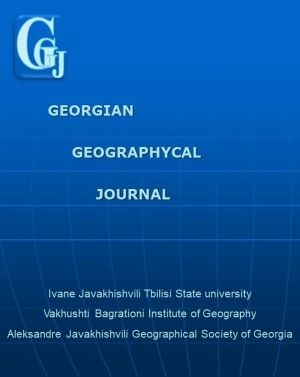Tbilisi Through Time
DOI:
https://doi.org/10.52340/ggj.2022.758Keywords:
urban sprawl, urban expansion, Tbilisi, GeorgiaAbstract
Ancient cities have witnessed many changes throughout their long history. These changes have different underlying causes in different regions of the world. This paper discusses the urban sprawl of Tbilisi, the capital of Georgia, mainly from the beginning of the 19th century to 2020. Through analysis of historical materials, city plans, and old maps, layers of Tbilisi urban sprawl were created using ArcMap 10.8. Images of Landsat 5 TM and Landsat 8 OLI have been used to assess changes over the last 30 years. We compared the obtained data with the census data conducted during the study period, reconstructed the current social, political, and economic situation using historical sources, and finally determined in which period the urban expansion took place, the reasons for it, and how this expansion affected the natural and social environments of the city.
Downloads
Metrics
References
Jin, J., Gubbi, J., Marusic, S., & Palaniswami, M. (2014). An information framework for creating a smart city through internet of things. IEEE Internet of Things Journal, 1(2). https://doi.org/10.1109/JIOT.2013.2296516
Varzi, A. C. (2021). What is a City? Topoi, 40(2). https://doi.org/10.1007/s11245-019-09647-4
Williams, T. (2014). Archaeology: Reading the City through Time. In Reconnecting the City: The Historic Urban Landscape Approach and the Future of Urban Heritage (Vol. 9781118383988). https://doi.org/10.1002/9781118383940.ch1
Oueslati, W., Alvanides, S., & Garrod, G. (2015). Determinants of urban sprawl in European cities. In Urban Studies (Vol. 52, Issue 9). https://doi.org/10.1177/0042098015577773
Brilhante, O., & Klaas, J. (2018). Green city concept and a method to measure green city performance over time applied to fifty cities globally: Influence of GDP, population size and energy efficiency. Sustainability (Switzerland), 10(6). https://doi.org/10.3390/su10062031
Van Assche, K., & Salukvadze, J. (2012). Tbilisi reinvented: Planning, development and the unfinished project of democracy in Georgia. Planning Perspectives, 27(1). https://doi.org/10.1080/02665433.2011.601611
Gadrani, L., Lominadze, G., & Tsitsagi, M. (2018). F assessment of landuse/landcover (LULC) change of Tbilisi and surrounding area using remote sensing (RS) and GIS. Annals of Agrarian Science, 16(2), 163–169. https://doi.org/10.1016/j.aasci.2018.02.005
Tatashidze, Z. (2000). Tbilisi. In Z. Tatashidze, K. Kharadze, J. Kekelia, & R. Khazaradze, Geography of georgia, Part 1, Physical Geography (pp. 200-207). Tbilisi: Metsniereba (in Georgian)
Meskhia, Sh., Gvritishvili, D., Dumbadze, M., Surguladze, A. (1958). History of Tbilisi. Tbilisi: State Publishing House for Children and Youth Literature
Ukleba, D. (1989). The nature of Tbilisi and its surroundings. Tbilisi: Soviet Georgia.
Movement DOCU, (2021). Urban sprawl. Film, Bakuradze, A., Qadagishvili, E.
Gadrani, L., Tsitsagi, M., & Tielidze, L. (2019 Urban Landscape of Georgia (On the Example of Large Cities). Springer International Publishing. https://doi.org/10.1007/978-3-319-77764-1_6
Van Assche, K., & Salukvadze, J. (2012). Tbilisi: Urban transformation and role transformation in the post-Soviet metropolis. In Remaking Metropolis: Global Challenges of the Urban Landscape. https://doi.org/10.4324/9780203095485
Asatiani N. (2015). Urban development problems in Georgia in 1960-1970. ARS Georgia, Series B. ISSN 1512-4088
Alpaidze, L., & Pace, R. (2021). Ecosystem Services Provided by Urban Forests in the Southern Caucasus Region: A Modeling Study in Tbilisi, Georgia. Climate, 9(11), 157. https://doi.org/10.3390/cli9110157
Downloads
Published
How to Cite
Issue
Section
License
This work is licensed under a CC BY Attribution




